Selecting the appropriate **guitar amplifier** is essential for enhancing your playing experience and shaping your sound.
A variety of options are available, including **tube**, **solid-state**, and **modeling amplifiers**. It is crucial to understand the differences among these types.
Key factors such as **power**, **tone**, **portability**, and **budget** significantly influence the decision-making process.
This guide will address the key features to consider, provide tips for identifying the **perfect match** for your musical style, and offer strategies for maximizing the potential of your amplifier.
Engage with this content to learn how to enrich your **musical journey**.
What is a Guitar Amp?
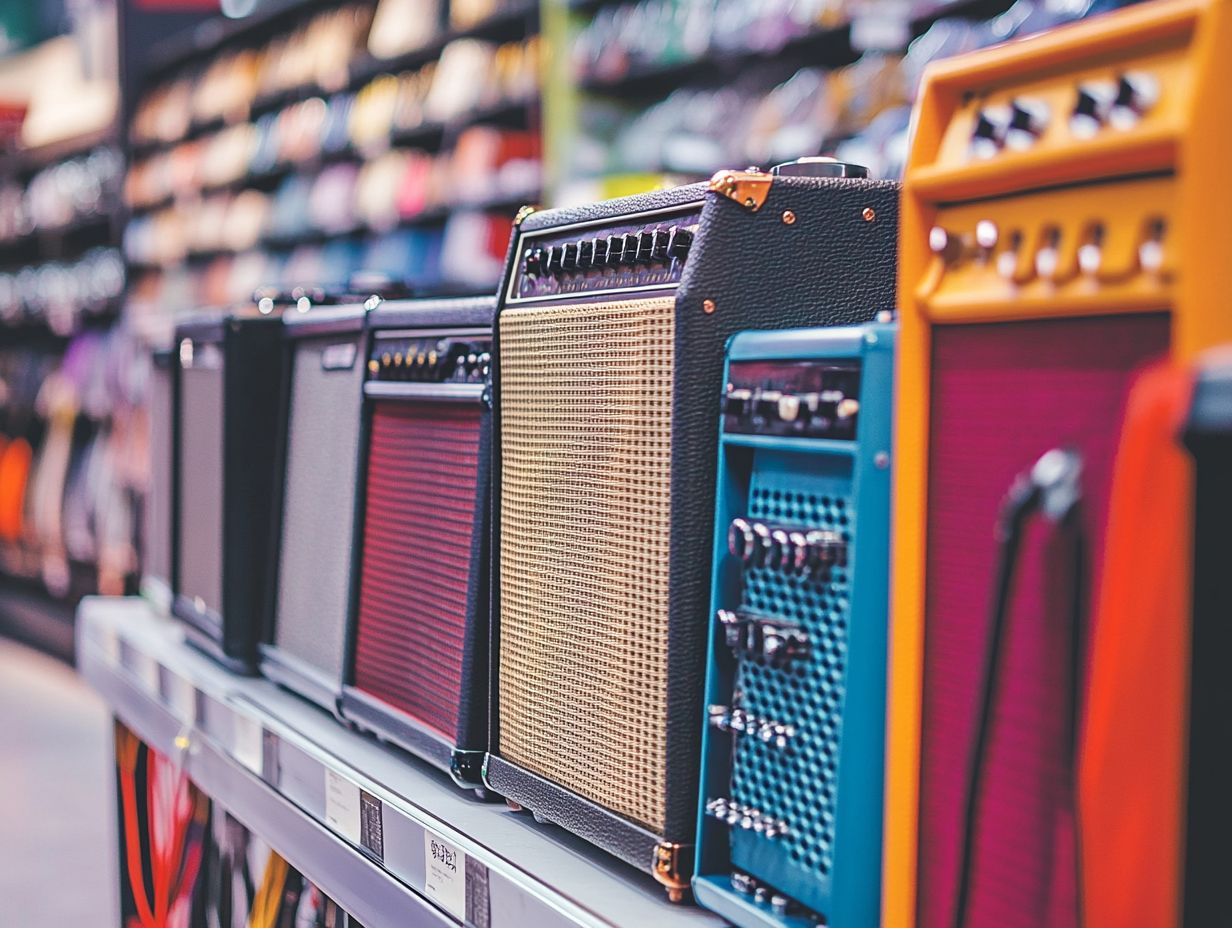
A guitar amplifier, often referred to as an amp, is an essential device that enhances the sound of an electric guitar, allowing musicians to achieve their desired tone and volume.
There are various types of amplifiers, including tube amplifiers, solid-state amplifiers, and modeling amplifiers, each providing distinct sound characteristics and features that cater to different playing styles.
The selection of a guitar amplifier can significantly impact overall sound quality and performance, making it crucial for both beginners and professionals to comprehend the differences among these options and choose the most suitable amplifier for their specific needs.
Types of Guitar Amps
When selecting a guitar amplifier, it is essential to understand the various types of amplifiers available in order to achieve the desired tone, performance, and sound characteristics.
The three primary categories of guitar amplifiers are:
- Tube amplifiers, which are renowned for their warm sound and dynamic response;
- Solid-state amplifiers, which provide reliability and consistent audio output;
- Modeling amplifiers, which simulate a range of amplifier sounds and effects for enhanced versatility.
Each type possesses its own strengths and weaknesses, rendering them suitable for different playing styles and budget considerations.
Tube Amps
Tube amplifiers are highly esteemed among guitarists for their exceptional sound quality, distinguished by a warm clean tone and the capacity to produce harmonic distortion and overdrive when operated at higher gain settings. These amplifiers employ vacuum tubes to amplify audio signals, imparting a unique tonal character that many musicians find desirable, particularly in genres such as rock and blues.
While the depth and warmth associated with tube amplification can significantly enhance a performance, these amplifiers also present certain disadvantages. One notable advantage is their ability to generate a complex tonal range, enriching a musician’s sound palette; however, this complexity often requires meticulous maintenance and specific handling to ensure optimal performance.
Furthermore, tube amplifiers tend to be heavier and less portable than their solid-state counterparts, which may affect their practicality for performing artists. Additionally, the lifespan of vacuum tubes can vary, necessitating periodic replacements that can contribute to long-term costs, especially when contrasted with the generally higher durability and fidelity ratings of other amplifier types.
Solid-State Amps
Solid-state amplifiers are renowned for their reliability and cost-effectiveness, making them a favored option for both novice and professional musicians. These amplifiers utilize transistors in place of vacuum tubes, resulting in a lightweight and compact design that delivers consistent performance across various wattage levels, while also minimizing the need for frequent maintenance.
This reliability significantly reduces concerns about equipment failures during performances, which is a considerable advantage for artists operating within a budget. Solid-state amplifiers typically generate a clean and precise sound, which appeals to musicians who prioritize clarity over the vintage warmth associated with tube amplifiers.
However, some musicians may perceive these amplifiers as lacking the dynamic nuances provided by tube models, particularly at higher gain settings. It is also essential to evaluate the financial implications; while solid-state options often present a more economical choice initially, some individuals may ultimately prefer the richer tonal qualities of tube amplifiers as they progress in their musical endeavors.
The portability and lower maintenance requirements of solid-state amps render them an excellent choice for those beginning their journey or seeking dependable equipment for live performances.
Modeling Amps
Modeling amplifiers represent a contemporary approach to guitar amplification, providing a wide range of built-in effects and sounds that effectively replicate classic amplifiers and various musical styles. These versatile amplifiers utilize digital technology to simulate different amplifier types, enabling musicians to experiment with tone shaping and sound characteristics without the need for multiple physical amplifiers.
Plus their remarkable sound designs, these amplifiers frequently offer diverse connectivity options, allowing compatibility with a variety of pedals and external devices. Musicians can easily integrate effects pedals into their setups through dedicated effects loops, which enhances their capacity to create unique soundscapes.
This overall flexibility not only accommodates different playing styles but also facilitates seamless performances in various environments, from home studios to live venues. Consequently, players can explore an expansive tonal palette, thereby furthering their creative expression and musical exploration.
Factors to Consider When Buying a Guitar Amp
When purchasing a guitar amplifier, several critical factors must be taken into consideration, as they can significantly influence the overall experience and satisfaction.
It is essential to evaluate sound quality, the amplifier’s price range, portability for ease of transportation, and the specific features that align with your playing style—such as tone control, wattage, and connectivity options.
Power and Wattage
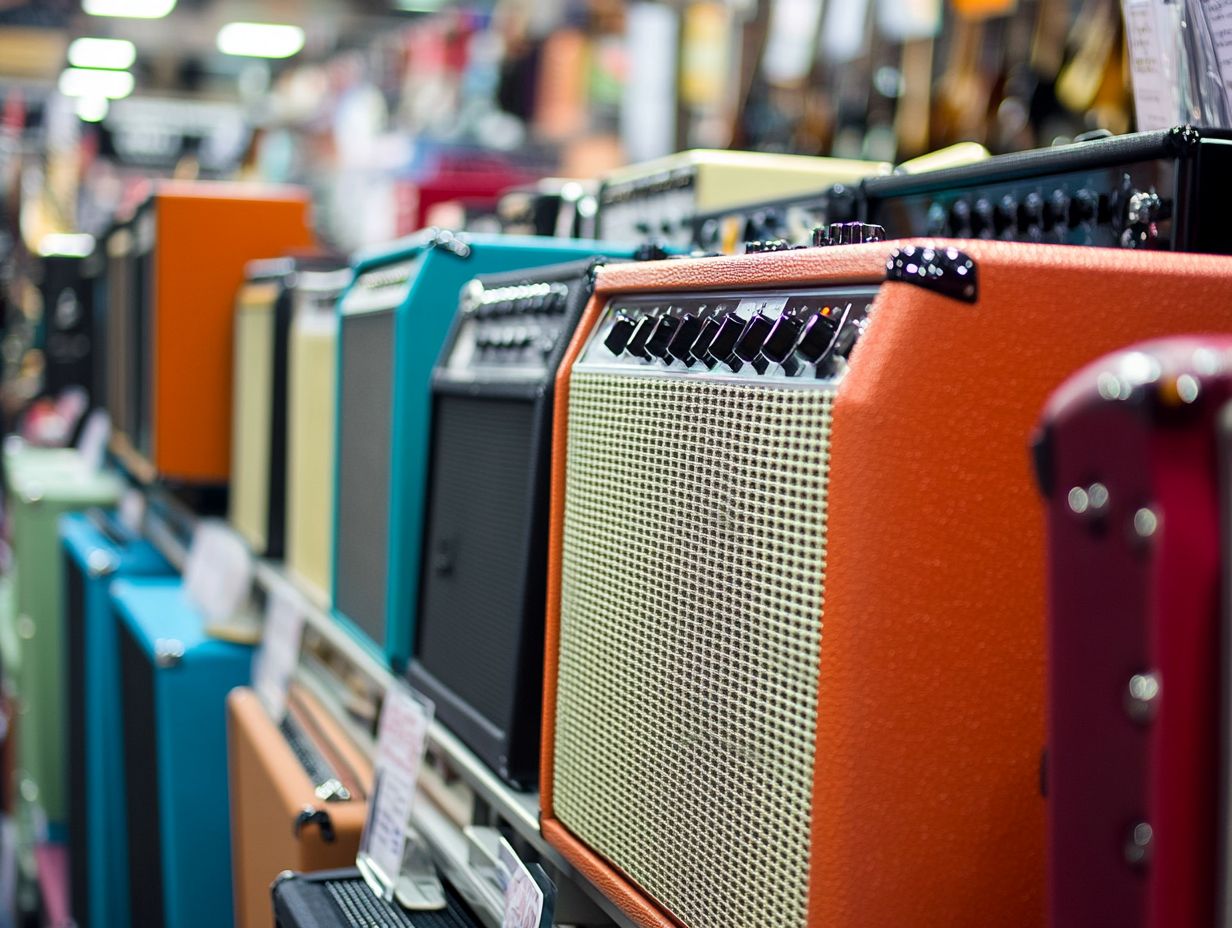
Power and wattage are essential specifications to consider when selecting a guitar amplifier, as they directly influence the amplifier’s audio output and overall volume capabilities. Generally, higher wattage permits cleaner tones at elevated volumes; however, the optimal choice is contingent upon whether the amplifier is intended for practice sessions, home studio use, or live performances.
A thorough understanding of the relationship between wattage and sound quality can assist musicians in achieving the appropriate balance between a clean tone and desirable distortion. For example, lower-wattage amplifiers may provide a more saturated sound at reduced volumes, making them ideal for studio environments, while higher-wattage models excel in delivering dynamic responses in larger venues where power is paramount.
When selecting an amplifier, it is important to consider the performance space and the genre of music being played to determine the suitable power rating. Ultimately, a well-matched amplifier will enhance the sound without sacrificing clarity, facilitating an engaging audio experience across various settings.
Tone and Sound Quality
Tone and sound quality are critical considerations for any guitarist, as they fundamentally shape the overall character of musical expression and performance. An amplifier equipped with effective tone control features facilitates enhanced manipulation of tonal range, leading to improved audio clarity and frequency response across various playing styles.
It is essential to comprehend how different amplifiers achieve these tonal qualities. For example, tube amplifiers are renowned for producing warm, rich tones that are particularly suited for genres such as blues and rock, owing to their natural compression and harmonic distortion. Conversely, solid-state amplifiers generally deliver a cleaner sound with higher headroom, catering to those who seek a more pristine audio output.
Adjustable equalization settings, including bass, midrange, and treble controls, provide guitarists with the flexibility to fine-tune their sound. This versatility not only enhances live performances but also fosters greater creativity in the studio, where tailored sounds can significantly impact production quality.
Portability and Size
Portability and size are critical factors for musicians who frequently transport their equipment, particularly those who perform live. Lightweight and compact designs are often preferred for gigging amplifiers, facilitating easy transportation without compromising sound quality or performance.
Achieving the right balance between portability and sound excellence is essential, as musicians frequently navigate tight schedules and limited space within venues. When selecting equipment, a focus on well-engineered lightweight models can significantly enhance a performer’s experience.
A compact amplifier that delivers a rich, full sound not only boosts confidence during performances but also ensures a streamlined setup and breakdown process.
Musicians recognize that sacrificing audio fidelity for convenience is not a viable option; therefore, investing in equipment that offers both portability and superior acoustic quality is crucial for successful performances on the road.
Price and Budget
The price range of guitar amplifiers can vary considerably, making it essential for prospective buyers to establish a budget that aligns with their specific needs and expectations. Whether considering new amplifiers equipped with advanced features or used models that offer significant value, understanding one’s financial limits will facilitate the identification of the most suitable guitar amplifiers available in the market.
Exploring a variety of options may lead to the discovery of exceptional models that meet both sound quality and aesthetic preferences. New amplifiers typically come with manufacturer warranties and incorporate advanced technology, ensuring reliability and modern connectivity features; however, they may also carry a substantial price tag.
Conversely, used amplifiers represent an appealing alternative, often delivering rich tones at a more economical cost, although they may lack certain contemporary features and necessitate thorough inspection to identify any potential hidden issues.
Buyers should carefully evaluate these factors, as the optimal choice ultimately depends on individual priorities and intended use.
Features to Look for in a Guitar Amp
When evaluating guitar amplifiers, it is imperative to consider certain features that can significantly enhance the playing experience.
A comprehensive checklist for amplifier features may include options such as:
- Effects and channels for sound variation
- Speaker configuration to ensure optimal audio output
- A range of connectivity options to provide versatility in different setups
Effects and Channels
Effects and channels play a crucial role in shaping a guitarist’s sound, enabling the achievement of various tones and effects through built-in features or additional pedals. A high-quality amplifier typically includes an effects loop for the integration of external effects, gain control for adjusting distortion levels, and pedal compatibility to enhance versatility.
The variety of effects available can significantly transform the tonal landscape, allowing musicians to experiment with a range of sounds from lush reverbs to sharp delays. The effects loop facilitates a seamless integration of these external pedals, ensuring that the overall sound remains clean and dynamic.
Additionally, gain control is essential for not only adding grit and sustain but also for achieving a delicate balance between clarity and saturation. Overdrive, often favored by guitarists, provides a warm and natural distortion that enhances the expressiveness of the performance.
By understanding these components, players can unlock new dimensions in their sound, thereby enriching their overall musical experience.
Speaker Configuration
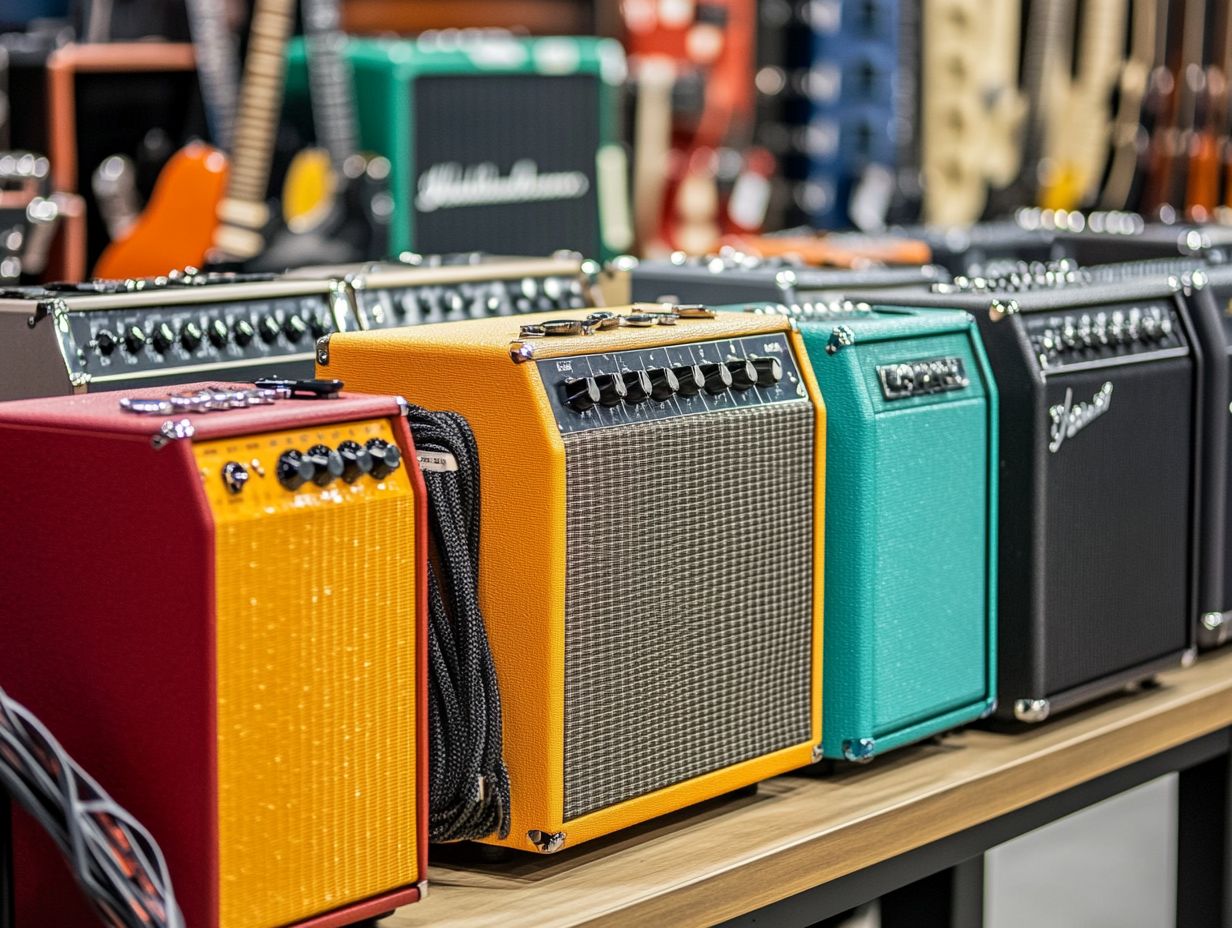
The speaker configuration of a guitar amplifier is essential for determining its audio output and overall sound character. Various factors, including speaker size, cabinet design, and impedance, can significantly influence the amplifier’s performance, affecting both volume and tonal qualities.
Larger speakers generally produce a fuller sound with deeper bass response, making them particularly suited for heavier music styles such as rock and metal. In contrast, smaller speakers tend to deliver a tighter, more focused tone, which aligns well with genres such as jazz or blues.
Furthermore, the cabinet design—whether open-back or closed-back—affects the interaction of sound waves with the environment, thereby enhancing or diminishing specific frequencies.
Impedance is also a critical factor; matching the amplifier’s output impedance to that of the speakers is necessary to ensure optimal power transfer. This matching can enrich dynamic range and improve overall clarity, ultimately accommodating a variety of musical expressions and preferences.
Connectivity Options
Connectivity options in a guitar amplifier are essential for contemporary musicians, facilitating seamless integration with other equipment and enhancing overall versatility. Features such as multiple jack inputs, headphone outputs for silent practice, and footswitch capabilities for efficient effect switching are critical for both live performances and studio environments.
Musicians today often prioritize amplifiers that provide a diverse array of connectivity features, as these attributes can significantly impact practice experiences and performance capabilities.
For instance, USB ports enable straightforward recording and playback, simplifying the process of capturing ideas or sharing performances. Additionally, Bluetooth connectivity has become increasingly popular, allowing artists to connect wirelessly to backing tracks or control settings from a distance.
The significance of these features cannot be overstated, as a well-equipped amplifier can greatly enhance creativity and adaptability, whether on stage or within the confines of one’s own home.
Tips for Choosing the Right Guitar Amp
Selecting the appropriate guitar amplifier necessitates careful consideration and a degree of experimentation to ensure it aligns with one’s musical style and preferences.
A highly recommended approach is to test various amplifiers in person, which enables an assessment of their sound quality, features, and compatibility with your playing style prior to making a purchase decision.
Trying Out Different Amps
Experimenting with different amplifiers is essential for identifying the optimal match for one’s guitar sound, as each amplifier presents distinct sound profiles and tonal characteristics. By evaluating multiple models and considering user feedback, individuals can conduct informed comparisons to ascertain which amplifier best meets their requirements.
Live demonstrations enable musicians to hear how various amplifiers interact with their specific guitars and playing styles in real-time. This dynamic testing is further enhanced by insights from fellow musicians who have previously navigated the selection process. Their experiences can illuminate specific strengths or weaknesses in sound quality and responsiveness, serving as a comprehensive resource for prospective buyers.
Engaging in amplifier comparisons also facilitates an understanding of how different settings and effects can alter the overall tone, ultimately guiding individuals toward a more satisfying final decision.
Considering Your Playing Style
The playing style of an individual is a critical consideration when selecting the appropriate guitar amplifier, as various styles may necessitate distinct tonal characteristics and features. Whether one is a beginner seeking a straightforward setup or a professional requiring versatile options for multiple genres, aligning the choice of amplifier with the specific playing style is essential for achieving optimal performance.
For example, a blues guitarist may prioritize warm, overdriven tones that are more effectively produced with tube amplifiers, while a metal guitarist often seeks high gain and clarity, which can be found in premium models or solid-state options.
Beginners may find it advantageous to utilize combo amplifiers that provide a variety of built-in effects, facilitating the exploration of different sounds without the need for extensive equipment. In contrast, experienced musicians might prefer modular setups that enable them to switch between professional amplifiers tailored to their specific requirements, thereby expanding their creative possibilities.
Ultimately, comprehending the relationship between playing styles and amplifier features not only enhances the overall sound but also contributes to a more enjoyable playing experience.
Frequently Asked Questions
What is a guitar amp and why do I need one?
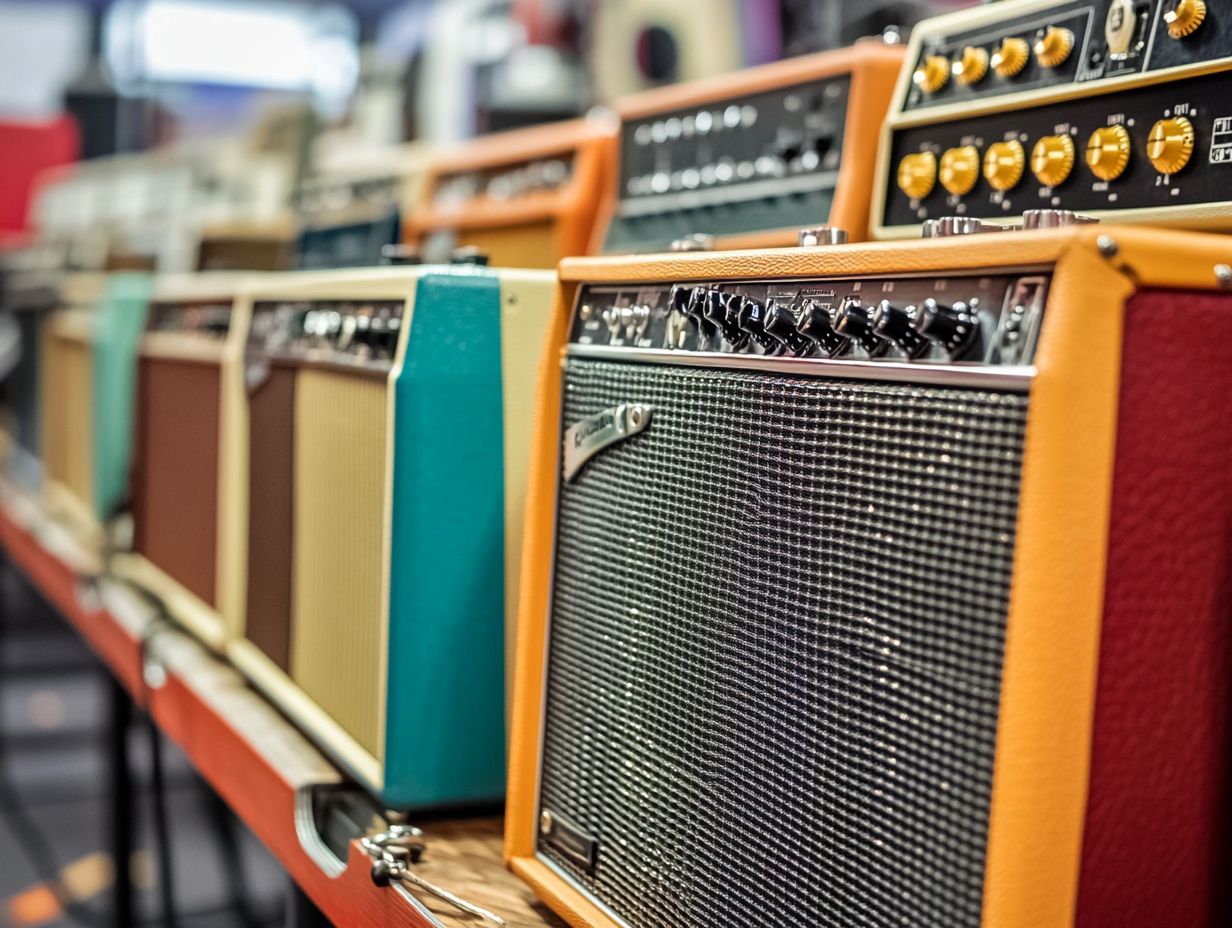
A guitar amp, short for guitar amplifier, is a device used to amplify the sound of an electric guitar. It is an essential piece of equipment for any guitarist as it allows them to control the volume and tone of their instrument, making it louder and more versatile.
What are the different types of guitar amps available?
There are three main types of guitar amps: tube, solid-state, and modeling. Tube amps use vacuum tubes to amplify the signal, resulting in a warm and classic sound. Solid-state amps use transistors and are known for their reliability and affordability. Modeling amps use digital technology to mimic the sound of different types of amps and effects.
What should I consider when buying a guitar amp?
When buying a guitar amp, consider factors such as wattage, size, and budget. The wattage will determine the volume and power of the amp, while size will affect portability. Your budget will also play a significant role in determining the type and quality of amp you can purchase.
What is the difference between a combo amp and a head and cabinet setup?
A combo amp is an all-in-one unit that includes both the amplifier and speaker(s) in a single package. A head and cabinet setup consists of a separate amplifier head and speaker cabinet, which allows for more versatility in terms of customization and upgrading. Combo amps are more suitable for beginners, while head and cabinet setups are preferred by more experienced musicians.
Do I need any additional equipment to use a guitar amp?
Yes, you will need a guitar cable to connect your guitar to the amp, as well as a power source. Some amps also come with built-in effects, but you may need to purchase pedals or other effects units separately.
Is it better to buy a guitar amp online or in-store?
It ultimately depends on your personal preference and comfort level. Buying online may offer a wider variety of options and potentially better deals, but you won’t be able to try out the amp before purchasing. Buying in-store allows you to test the amp and get a feel for its sound and features, but the selection may be more limited.

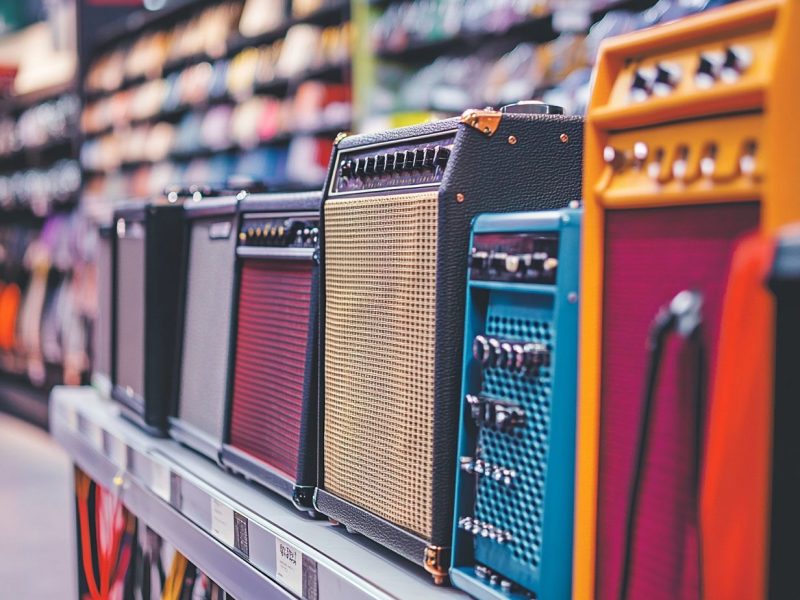
 Discover Affordable Synthesizers Under $500 – Get Your Dream Sound!
Discover Affordable Synthesizers Under $500 – Get Your Dream Sound!